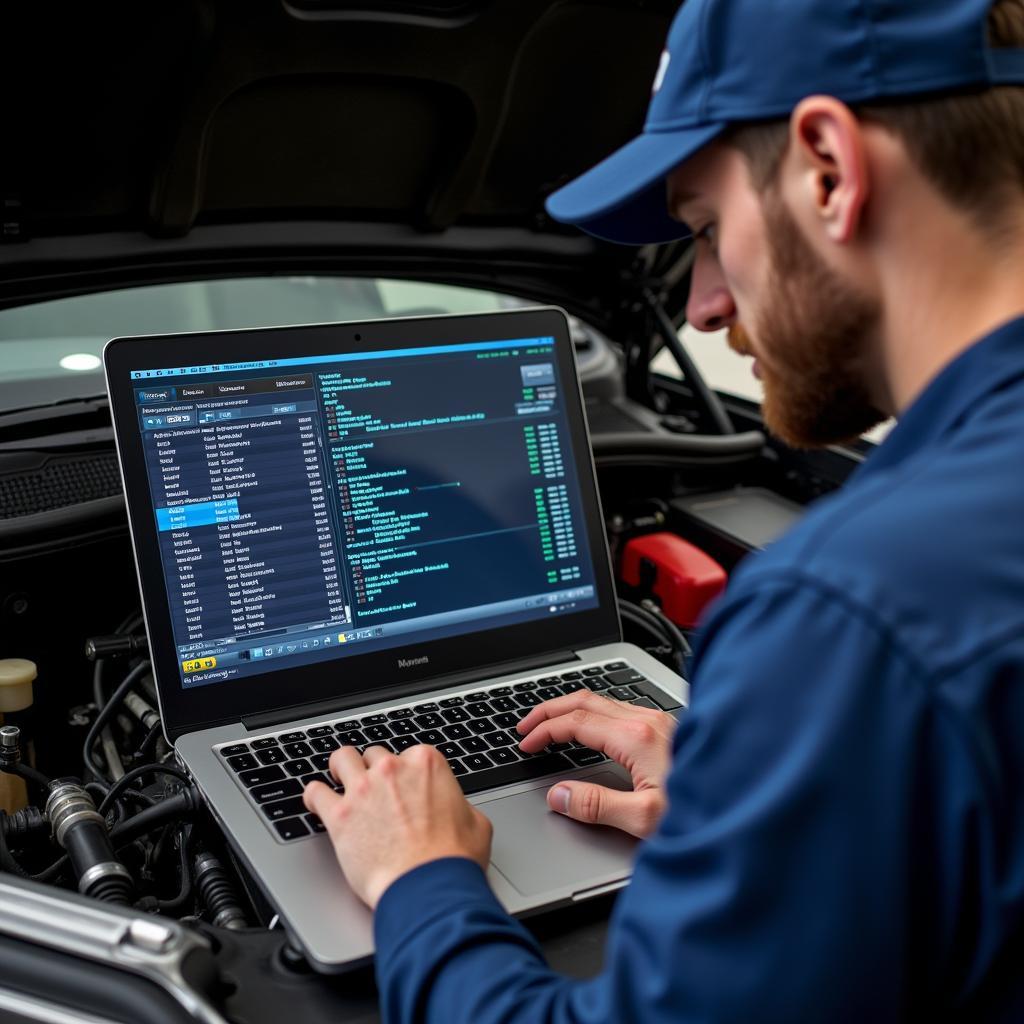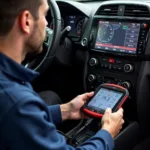Performing car diagnostics with a laptop has become increasingly accessible and empowers car owners to understand their vehicles better. Whether you’re a seasoned mechanic or a curious car enthusiast, this guide will equip you with the knowledge and steps needed to perform effective car diagnostics using your laptop.
Connecting a laptop to your car’s onboard diagnostic (OBD-II) port opens a gateway to a wealth of information about your vehicle’s health. From identifying a pesky check engine light to monitoring real-time sensor data, laptop-based diagnostics provide a comprehensive view of your car’s systems. Want a full car diagnostic test near me? Check out our resources!
Accessing this information previously required expensive, specialized tools, but today’s market offers affordable diagnostic software and hardware, making DIY car diagnostics a reality. With the right tools and a little know-how, you can save money on mechanic visits and gain a deeper understanding of your vehicle. This guide will walk you through the process, helping you choose the right tools, understand the software, and interpret the data.
Choosing the Right Diagnostic Hardware and Software
Before diving into the diagnostic process, you need the right tools. This includes a diagnostic cable, often referred to as a car diagnostic cable, and compatible software. The cable connects your laptop’s USB port to the car’s OBD-II port, typically located under the steering wheel.
Several excellent diagnostic software options cater to different skill levels and budgets. Some popular choices include TOAD car diagnostic software and others. Consider factors like user-friendliness, features, and vehicle compatibility when making your selection. You can also research car diagnostic prices for a better understanding of the associated costs.
Connecting Your Laptop to the Car
Once you have the necessary hardware and software, connecting your laptop to the car is a straightforward process. Locate the OBD-II port on your vehicle. Plug the diagnostic cable into the port and the other end into your laptop’s USB port. Turn the ignition key to the “on” position without starting the engine. This powers up the car’s computer and allows the diagnostic software to communicate with it.
Performing the Diagnostic Scan
With your laptop connected and the software running, you can begin the diagnostic scan. Most software offers various scan options, ranging from a quick check for trouble codes to a more comprehensive system scan. Select the appropriate scan based on your needs. The software will then communicate with the car’s computer, retrieving diagnostic trouble codes (DTCs) and other relevant data.
Understanding Diagnostic Trouble Codes (DTCs)
DTCs are alphanumeric codes that represent specific malfunctions within the vehicle’s systems. Each code corresponds to a particular problem, such as a faulty sensor or a malfunctioning component. For example, the CTECH OBD2 Wifi car diagnostic tool might display a code related to the oxygen sensor.
Don’t be intimidated by these codes. Many online resources provide detailed explanations of what each DTC means. You can also find helpful guides and forums where experienced mechanics and car enthusiasts share their knowledge.
 Mechanic Analyzing Diagnostic Data on Laptop
Mechanic Analyzing Diagnostic Data on Laptop
Interpreting the Diagnostic Data and Next Steps
After the scan, your software will display the retrieved DTCs and other relevant data. Take the time to understand what each code means and its potential implications. This information can help you pinpoint the root cause of a problem and determine the necessary repairs.
While diagnostic software provides valuable insights, it’s crucial to remember it’s just a tool. It doesn’t replace a qualified mechanic’s expertise. Use the information gathered as a starting point for further investigation and diagnosis. If you are unsure about interpreting the results or performing the necessary repairs, consult a professional.
Conclusion
Performing car diagnostics with a laptop is a powerful way to understand your car’s health and potentially save on repair costs. By following the steps outlined in this guide and utilizing the available resources, you can gain valuable insights into your vehicle’s performance and maintain it effectively. Remember, understanding how to perform car diagnostics with a laptop is an invaluable skill for any car owner.
FAQ
- What is an OBD-II port? The OBD-II port is a standardized connector found in most vehicles manufactured after 1996. It allows access to the vehicle’s diagnostic system.
- Do I need special software to perform car diagnostics with a laptop? Yes, you need compatible diagnostic software that can communicate with your vehicle’s computer.
- Can I fix any car problem with diagnostic software? Diagnostic software helps identify potential issues, but it doesn’t fix them. Repairs may still be necessary.
- Is laptop-based car diagnostics difficult? With the right tools and a little learning, it’s surprisingly easy to perform basic car diagnostics.
- Where can I find more information about DTCs? Numerous online resources and forums offer detailed information about diagnostic trouble codes.
Need support? Contact us via WhatsApp: +1(641)206-8880 or Email: [email protected]. Our customer support team is available 24/7.


